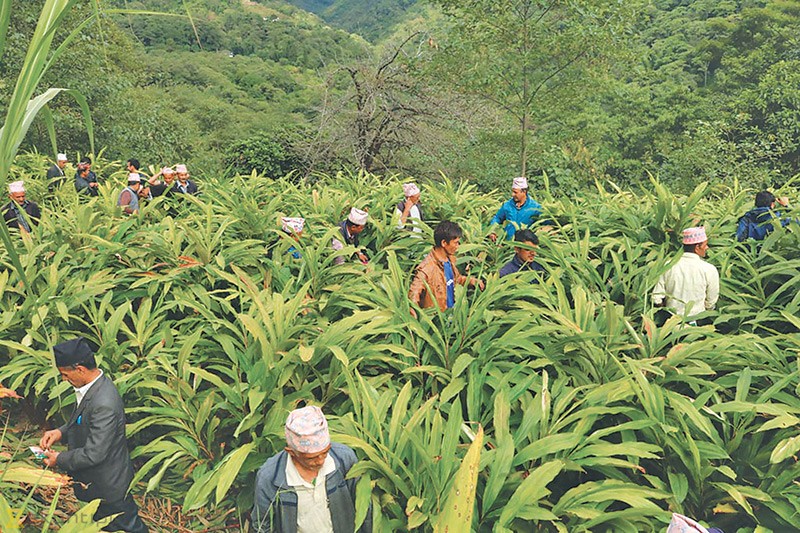Scientific Name: Amomum subulatum
Family: Zingiberaceae
Common name: Cardamom(English), Alaichi(Nepali)
Altitude: 600-2300m above mean sea level
Season: April-May
Parts used: Fruit
Description:
 |
| Cardamom(a) |
Cardamom is a herbaceous perennial plant of ginger family most commonly used as spices. It grows 2-4 m in height. The leaves are alternate in two ranks, 40–60 cm long, with a long pointed tip. The flowers are white to lilac or pale violet, produced in a loose spike which is 30–60 cm long. The fruit is a three-sided yellow-green pod 1–2 cm long, containing several black and brown seeds(15-20). Botanically, cardamom is a herb mentioned with great medicinal values in ayurveda and named as Brihadela in Sanskrit. It is native to Nepal, India, Bhutan, Indonesia.
Uses:
- It is used as a popular spice and proved to enhance digestion process along with stimulating metabolism (1*)
- It shows anti-oxidative, anti-inflammatory and anti-tumerogenic effects. (2*,3*)
- It is one of the ingredients heart health experts suggest to include in your diet (4*)
- It can be used as mouth freshener as it enhances oral health due to its antimicrobial property(5*)
- It is used to prevent sore throats.
- Treats sleep trouble
- Supports weight loss
- Reports say it can be used to fight against asthma, bronchitis, and numerous respiratory diseases.(6*)
- It can be used as antidote to snake venom or scorpion venom (7*)
Cardamom cultivation:
 |
| Large Cardamom Farming in Nepal (Picture8*) |
Cardamom is one of the most important cash crops with huge export potential. It is mainly cultivated in Nepal, Sikkim, Uttarakhand, Bhutan, Indonesia etc. Along with family labor and traditional wisdom, using modernized techniques of cultivation can establish our country as the largest organic hub of cardamom in the world. It grows well in shades of forest tress. Cardamom cultivation in Nepal is done in Shankhwasabha, Kavrepalanchowk and other diatricts.
 |
| Cardamom cultivation district profile |
Many factors like soil, climate, altitude, rainfall etc affect the success of cardamom cultivation. The method of traditional cultivation seems to be more viable than the modernized chemical farming system since it uses the local resources and does not have any adverse effect in the environment as well as human health. The process of Black cardamom cultivation along with necessary requirements is given below:
Soil and climate:
As stated earlier Cardamom grows best in the shades of tress in the altitude range of 600-2300m above the sea level. It requires rainfall of about 300-350 cm per annum. Land with moderate slope and organic loamy soil texture is necessary for successful cultivation with best yield. Contour terraces can be made before plantation to ensure that soil moisture and fertility is not lost due to erosion or other natural phenomenon.
Propagation:
Propagation is commonly done through seeds and suckers. High yielding disease free seedlings can be grown by the propagation of seeds. It ensures higher productivity. For rapid multiplication of higher yielding clones, vegetative buds form disease free mother are taken and plantlets are produced by the technique of tissue culture. The seeds are generally sown in September-October, the seed beds are made and then they are covered with fine soil along with mulching. Watering is done at regular intervals. Germination may take place after 25-30 days of seed sowing. Then the seeding are planted in April- May and watered regularly. After one month of primary care the plants can be transferred to main field in the moth of June-July.
Plantation:
Large Cardamom grows well in the shades of tress like Utis, Chilaune, Dhupi, Katus etc. The land selected for planting is made free of weeds. It is made sure that the soil is moist enough, loamy texture with gentle slopes. After plantation, the base of the plants are mulched with dry leaves. Decomposed cattle manure, compost manure along with crop residue are used to enhance soil fertility.
Weeding:
To ensure that maximum soil moisture and nutrient is done by the plants, we must focus on weed control. At the initial 2-3 years of plant growth is very necessary that proper care is given for the effective weed control. Both the methods of hand weeding or sickle weeding can be employed. The dead and dried shoots collected during weeding can be used as organic manure for the plant field.
 |
| Cardamom cultivation (Picture9*) |
Irrigation:
It has been noticed that the plants where irrigation facilities are available have higher production potential. So, according to the availability of water resources nearby, hose, sprinkler or flood irrigation through channels can be done.
Diseases and other attacks:
Large cardamom is mainly attacked by fungal and bacterial diseases while some virus are also observed. Similarly, pests, leaf eating caterpillars, aphid attacks are also obstacles to the cultivation. Aphid attacks cause the viral diseases like Chirke and Fookrey. For management of these problems a constant watch has to be maintained on diseased plants and have to be separated from the fields.
Harvesting and curing:
 |
| Large cardamom product |
The topmost capsule turning brown is the indication of harvesting. the spikes are cut by special knives. The spikes are heaped and capsules are separated and dried. In traditional method the capsules are dried by direct heating where the product come in contact with the smoke and appear brownish. To improve the appearance of the product, indirect heating at 45-50 degree Celsius is done in modern technique.
References: Cultivation of Large Cardamom, Wikipedia






5 Comments
Great!
ReplyDeleteWe will do agrobusiness😂
ReplyDeleteFor sure :-)
DeleteMalai chairathyo yo. Kati parxa achel esko?
ReplyDeleteMarket prices are available in customer care, please contact there mam
Delete